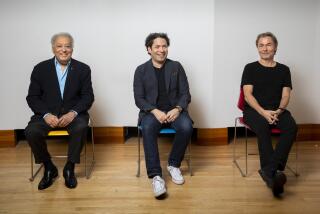Jazz Review : Phil Norman & Co. Marry Classic Jazz to Millennial : At Steamers, Band Broadens Definition of West Coast Sound
- Share via
During its four years, the Phil Norman Tentet has served as an audible archive, a living museum of the West Coast Sound and the works of such arrangers as Marty Paich, Dave Pell, Bill Holman and its own Bob Florence. But there was a new wrinkle or two when the 10-piece band performed at Steamers in Fullerton on Friday.
Although most of the Norman band’s material dates back at least 40 years, a piece performed at the close of the first set, written by respected composer and band pianist Florence, was straight out of the ‘90s. Carrying the thoroughly modern title of “Y2K Express,” the composition, which grew from an insistently repeated two-note piano figure, brought the West Coast tradition into the next millennium.
With the tune moving at a quick canter, the three-piece sax section joined that two-note figure, in counterpoint to the piano. As if to show that the past was not forgotten, the band moved through a few lines of Billy Strayhorn’s “Take the ‘A’ Train” before trumpeter Carl Saunders moved into a solo played faster than a download on a high-speed computer. Drummer Dick Weller attacked his kit with the strength and tenacity that typifies jazz drumming in the last half of the century.
The band showed another new wrinkle earlier in the set by including a piece from Quincy Jones. Though definitely not the kind of pop, rap and jazz hybrid that Jones currently favors, the tune--”Stockhom, Sweetin’ ” from Jones’ 1956 recording “This Is How I Feel About Jazz”--was a mid-tempo romp with a guitar, baritone sax and piano blend that carried modern, cosmopolitan airs, a decided change from the other bop-tied, West Coast swing and ballad numbers the group performed.
This particular edition of the Tentet was loaded with talent. Saxophonist Gary Foster brought his flowing bebop-styled alto play to the up-tempo improvisational section of “Y2K Express.” Trumpeter Saunders (who’s led his own combo here at Steamers) took an especially detailed fluegelhorn solo on “My Foolish Heart” that showed him to have the wind of a triathlete. Baritone saxophonist Roger Neumann played that unwieldy instrument as easily as if it were a child’s recorder. Guitarist Dave Koonse provided smart, attentive accompaniment.
Norman, whose greatest talent may be collecting high-caliber musicians and material, often defers improvisational space to his bandmates. Here, the saxophonist showed his instrumental skill on a Paich arrangement of “Angel Eyes,” a tune that featured fine play from flueglehornist-trumpeter Bob Summers and the group’s single trombonist, Charlie Loper.
Pianist Florence’s arrangements, central to the group’s sound, were here represented by his smooth readings of “Theme and Variations” and “On the Town,” both composed by big band leader Holman. Florence rendered Stan Kenton’s theme “Artistry in Rhythm” with a Latin feel while emphasizing the creamy blend of trombone and fluegelhorns that the pianist seems to favor. Los Angeles-based saxophonist Kim Richmond’s arrangement of “You Stepped Out of a Dream” turned its familiar, romantic theme into an assertive anthem, while Jim Dukey’s arrangement of “My Foolish Heart” gave room for Saunders to play a fluegelhorn solo as daring as stunt flying.
But it was the new material, and its seamless fit into the band’s repertoire, that gave this performance its uniqueness and created a new, expanded role for a band previously identified with a particular genre of jazz. In other words, the Phil Norman Tentet has a taste for the timely as well as the timeless.
More to Read
The biggest entertainment stories
Get our big stories about Hollywood, film, television, music, arts, culture and more right in your inbox as soon as they publish.
You may occasionally receive promotional content from the Los Angeles Times.










